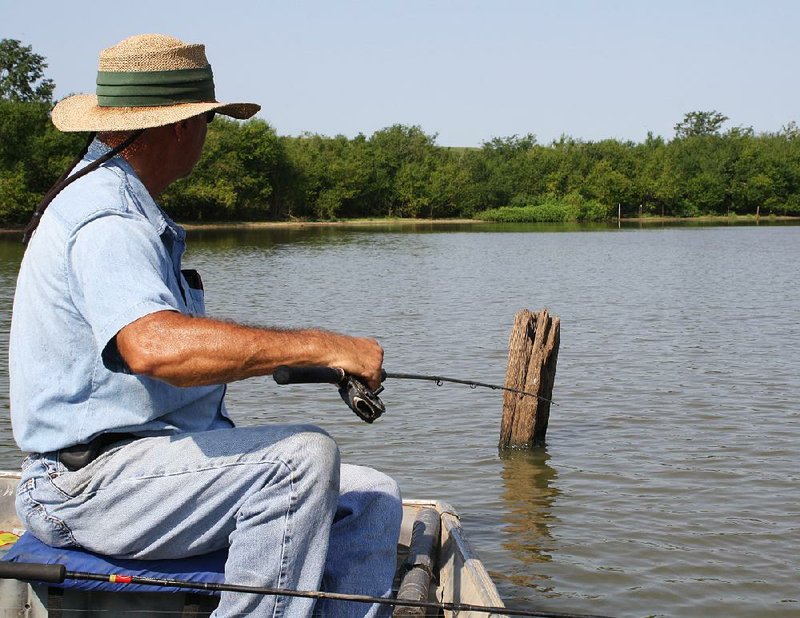Swirls in the water during a dove hunt along the Arkansas River made me wonder whether I should be fishing instead.
I was with Alan Thomas of Russellville during one of our riverside dove hunts at a place we call The Gully. As Al eased his Waco flatbottom into the little cove on the inshore side of a sandbar, we spooked several fish that were feeding in the shallows.
They might have been largemouth bass or striped bass. They were large, whatever they were, and since doves were scarce that afternoon, those fish consumed my thoughts.
Al and I brought fishing gear the next time we visited that spot, and it demonstrated the quality fishing opportunities that await anglers in the fall.
Mark Hedrick of Little Rock and Bill Eldridge of Benton fish year round, but fall is their favorite time. The weather is fair, the fishing is good, and competition is scarce because the summertime anglers have switched to hunting or other pursuits.
"My favorite time to fish is on a Saturday when the Razorbacks are playing at home," Hedrick said. "I love to see all those people driving north because that means they're not out on the water with me."
We "topsiders" don't notice a difference between September and August. The weather still feels hot and humid to us, but fish operate on a different calendar. They know winter is coming, and they spend autumn gorging to gain weight for winter.
Bass
In midsummer, bass in highland reservoirs orient to deep structure where cool water attracts baitfish and provides respite from the heat. Professional bass anglers call this "thermal refuge."
The weather doesn't feel much different to us in late summer and early fall, but shorter days and a more slanted light angle prompt fish to migrate to shallow water. This mimics the spring pattern when fish feed to regain the weight they lost in winter.
Because fish feed so aggressively in the fall, you can catch good numbers of big bass with crankbaits in shallow water. It's best after a rain, when an influx of fresh water cools and stains a lake or river.
George Cochran demonstrated this phenomenon in late August a couple of years ago when high water allowed easy access to some backwater areas on the Arkansas River. We caught a good number of big bass in water that was less than 5-feet deep on squarebill crankbaits and purple plastic worms. Then, we moved to the breakline where the main river met the backwater and caught more than a dozen big white bass beside a couple of big rocks in swift current.
At this time last year, Rusty Pruitt of Bryant and I experienced a stellar day of fishing on Lake Nimrod in Brush Creek. We caught largemouth and spotted bass, crappie and bream in a small area that was loaded with tiny threadfin shad.
Pruitt caught almost all of his fish with a fly fishing outfit, including a mess of crappie that schooled almost like white bass. We had never seen that before.
We repeated the scene a week later at Lake Atkins, where we cast to schools of white bass so vast that they looked like cloud shadows moving across the bottom.
That was also the day I found big largemouths inside the barrier of cypress trees against the north bank. They hit plastic frogs, but my medium weight tackle was no match for the size of bass that struck.
Crappie
Hedrick and Eldridge specialize in crappie, and fall is when they enjoy some of their best fishing.
Fall tactics are similar to those they use in early spring. Crappie in highland reservoirs like Ouachita, Maumelle, DeGray, Greeson, Beaver and Bull Shoals are suspended in or around shallow brushpiles. You can catch them by fishing minnows under floats or on tight lines, or you can catch them with light jigs and soft plastic tubes or shad imitators. The latter requires counting the bait down to the depth of the brush tops and swimming it slowly across the top. If your jig nicks the top of the brush, you're in the strike zone.
In shallow, lowland reservoirs, crappie relate to shade. Note the sunlight angle and fish live bait or tubes on the shady sides of trees, stumps, submerged fence posts and rubble.
Streams
Early fall is my favorite time for catching smallmouth bass on mountain streams. The crowds have left the Buffalo River and other popular canoeing streams, so this is when you see them at their finest.
The fishing is usually outstanding, and it's a great time to catch smallmouths on crankbaits and topwater lures. My favorite is an Excalibur Zell Pop, but you will catch plenty with Heddon Tiny Torpedoes and Zara Puppies.
It's a livelier style of fishing compared to summer, when you catch most of your fish on the bottom with soft plastics that imitate crawdads and lizards.
White Bass
For excitement, you can't go wrong fishing for schooling white bass on highland reservoirs in September.
They concentrate in the middle to lower parts of major reservoirs this time of year, and they chase shad on the surface in the last couple of hours of daylight on Maumelle, Ouachita and Hamilton and, as mentioned earlier, Lake Atkins.
When a school surfaces, throw a bone colored Zara Puppy into the middle of the scrum or in front of it. Fish will notice it as soon as it starts moving
Schooling whites this year are usually pretty big compared to summer, when the biggest fish lurk deep and catch straggling prey that escapes the smaller, more aggressive whites near the surface.
That's a great time to take a youngster for a few exciting hours after school.
Sports on 09/11/2016
